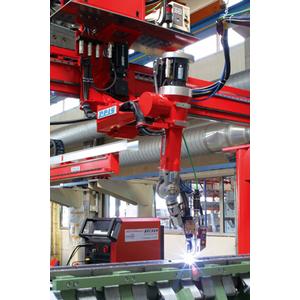The main linear axis of these robots specially designed for finishing is mounted in the longitudinal direction above the machine.
The 6-axis hybrid kinematics combines the advantages of linear robots with those of spherical robots. This construction offers a cylindrical working envelope parallel to the installation. The robot overhangs the machine and proceeds to load or unload parts from the side. The flexibility of the 6-axis spherical kinematics allows complex movements without the need to equip the wrist with additional rotation or tilting modules.
This concept is particularly well suited to cells with a small footprint. The suspended mounting of the robots and their low height allow for use in low ceiling production halls. In addition, it is possible to equip the machine on its sides with additional components or processing and assembly stations.
The linear axis, with a standard stroke of 1.5 m, can be extended, optionally, up to 40 m. This design allows the execution of a succession of operations such as machining, assembly, palletizing or packaging during the working cycle, and this, in the very enclosure of the cell.
This range includes 8 robots with a load capacity of 6 to 130 kg. Depending on the model, a speed of 1.5 to 3 m / s can be achieved on the linear axis, enabling short cycle times to be achieved, even in the case of multiple stations. A repeatability of +/- 0.05 mm predestines these robots in all applications requiring high precision.
The RVL REIS series offers a reasonable cost alternative, which, compared to traditional linear robots, is characterized by a higher flexibility and a small footprint on the ground.
The 6-axis hybrid kinematics combines the advantages of linear robots with those of spherical robots. This construction offers a cylindrical working envelope parallel to the installation. The robot overhangs the machine and proceeds to load or unload parts from the side. The flexibility of the 6-axis spherical kinematics allows complex movements without the need to equip the wrist with additional rotation or tilting modules.
This concept is particularly well suited to cells with a small footprint. The suspended mounting of the robots and their low height allow for use in low ceiling production halls. In addition, it is possible to equip the machine on its sides with additional components or processing and assembly stations.
The linear axis, with a standard stroke of 1.5 m, can be extended, optionally, up to 40 m. This design allows the execution of a succession of operations such as machining, assembly, palletizing or packaging during the working cycle, and this, in the very enclosure of the cell.
This range includes 8 robots with a load capacity of 6 to 130 kg. Depending on the model, a speed of 1.5 to 3 m / s can be achieved on the linear axis, enabling short cycle times to be achieved, even in the case of multiple stations. A repeatability of +/- 0.05 mm predestines these robots in all applications requiring high precision.
The RVL REIS series offers a reasonable cost alternative, which, compared to traditional linear robots, is characterized by a higher flexibility and a small footprint on the ground.
